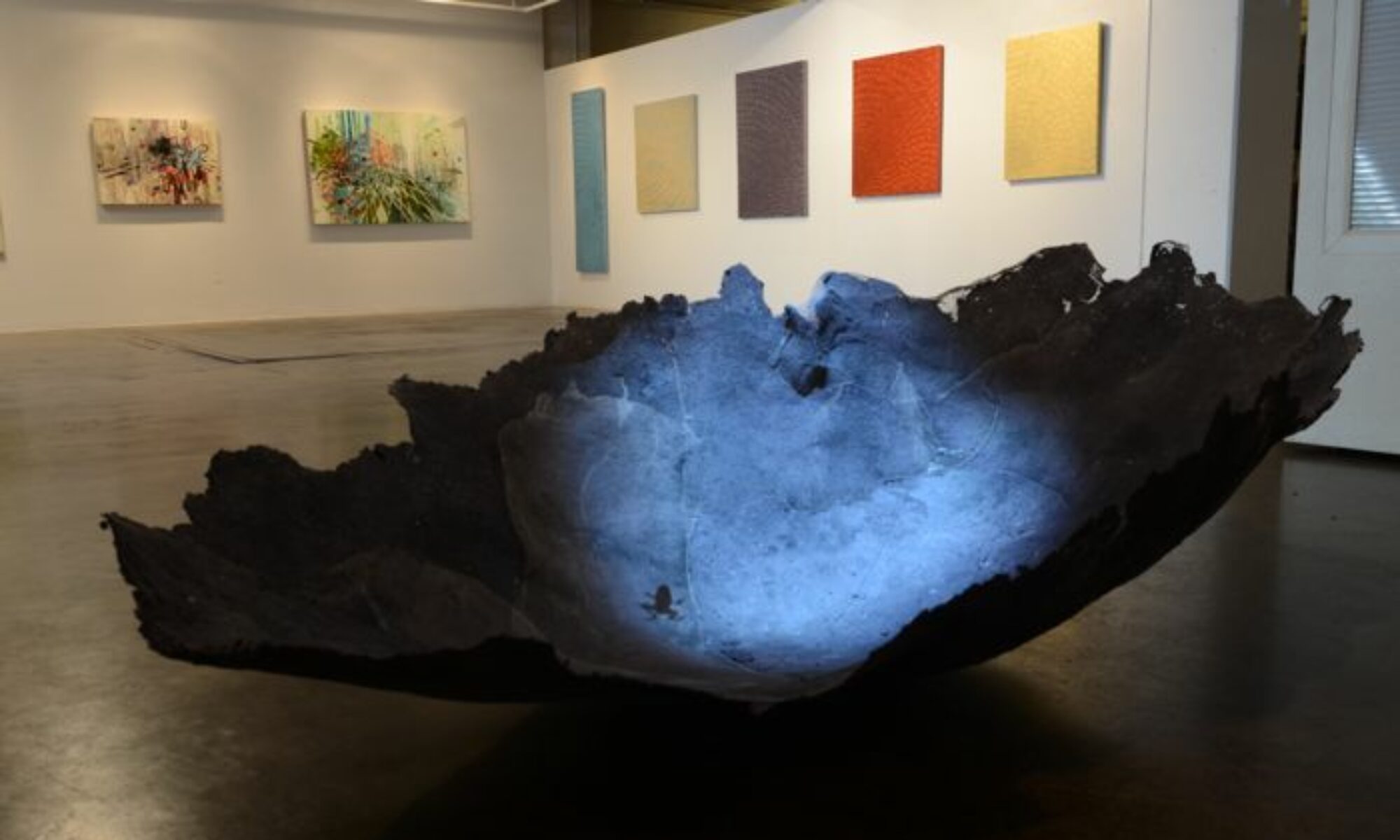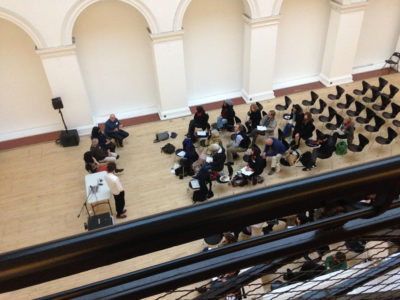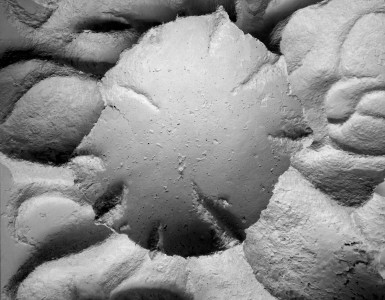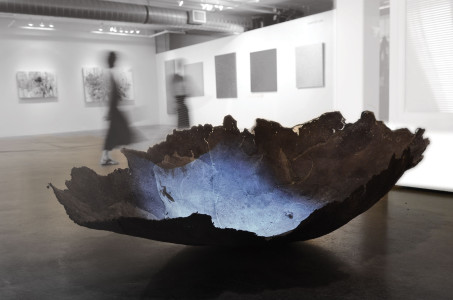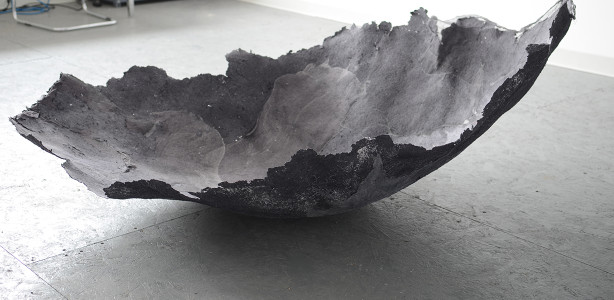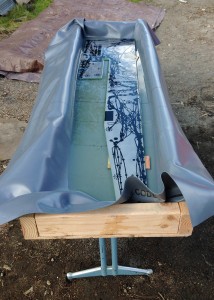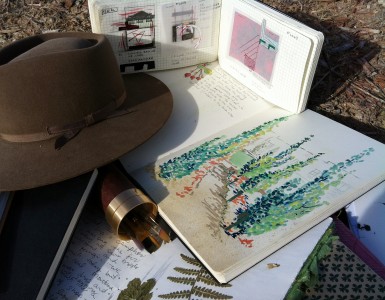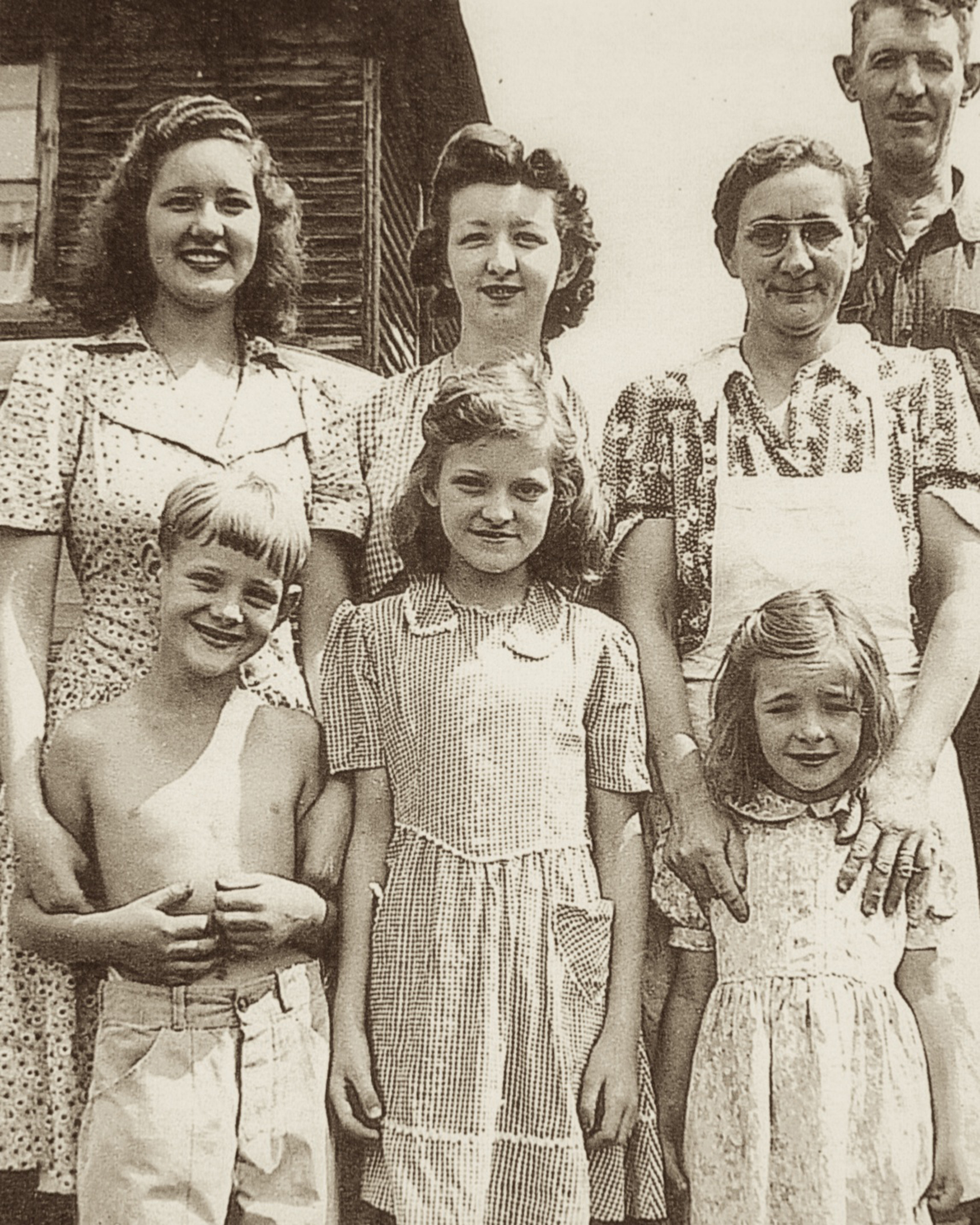Paper presentation, “Illustration and Design Thinking Methods in Landscape,” paper session, October 20-23, 2021, Design Communications Association (DCA), Perception to Execution, International Design Conference.
“The Agency of Landscape and Metaphor in Conceptual Illustration”
Spatial Models, Center for Faculty Development
Traversal
Frogs are known to be bio-indicators or an indicator species; their health can serve as a biological warning sign for the overall health of the environment in which they live. Traversal is an interactive sculpture inspired by several ponds: a forbidden pond of my youth and a pond in my back yard in Virginia. On a summer night, frogs would chirp. In desperation to be close to them, I would grab a flashlight and scramble outside to find them. In this collaboration with Bryan Leister, animated frogs swim, controlled by a sensor and infared light in a flashlight. Several flashlights used simultaneously can cause the frogs to become agitated, creating an environment of empathy for the animations.
molded paper pulp, cheesecloth, glue, ink
exhibition: April 22- May 31, 2014
Walker Fine Art, Denver, Colorado
Paper Skin Sculpture
One Three Dimensional Chair Process
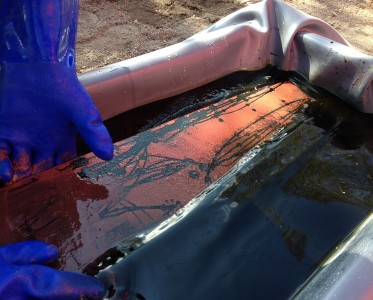
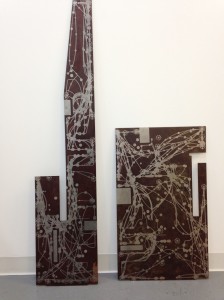 -In the field, I have been designing, constructing and finishing a metal sculpture, a new body of work. The work is collaboration in both concept and form.
-In the field, I have been designing, constructing and finishing a metal sculpture, a new body of work. The work is collaboration in both concept and form.
An augmented sculpture by Becky Heavner and Bryan Leister. One Three Dimensional Chair is both real and virtual, the steel sculpture and printed pattern is an abstract exploration of form. These patterns trigger an image of a virtual chair on a mobile device or tablet when the iOS or Android application below is installed. When the pattern is recognized by the application, a ‘real’ chair will appear in context to the space and can be interacted with.
Like Kosuth, we question the representation of things. The chair is an object, a description of properties and an instance of the object. In code, the chair is a collection of deconstructed one-dimensional parts as it is in reality. The internal logic of the form is mapped on the form itself. The patterns are tracings by virtual entities or agents who travel around the form, leaving a record of their path. The viewing device uses this record to display a form to the viewer that can be further manipulated and augmented with virtual living beings.
Plein Air: Animated Field Books Class Development
mind the gap
The field of landscape architecture is entering a new era. I think I feel it. Recently, I was in Austin, Texas attending a conference on landscape architecture. At the last minute, I changed my choice and entered a lecture a few minutes late. At the end, when questions were voiced, Anne Whiston Spirn, the third lecturer said, she had never seen research quite like the first two presentations. I too had been captivated by the research. These young voices had made and tested prototypes. If the profession of landscape architecture is not doing then it is important to make and do yourself. It was almost as if this conversion with myself was heard. Anne turned and asked the room of people if they also felt the field was changing. I think I felt it in that room. She asked “are other landscape architects making things like this and borrowing from other fields like industrial design? People agreed, Rhino is now being used and Processing to represent the data. I thought about my own experiments. If something is happening but not verbally acknowledged, it takes longer for change to happen. It was important for this photographer to voice something that some designers know. Yes, landscape architects use Rhino, Grasshopper and Processing. But more importantly, I believe she was saying landscape architects feel the need to make. Perhaps the field has been slipping into a gap, and now looking for a way out.
Today, I sat and listened to a sermon looking for a relevant message to take to heart. The minister spoke of a gap or void and of lost love. He said the intensity of love can’t be understood without a gap. It is important not to try to fill voids, but know they exist because intensity can’t be felt without them.
Salt of the Earth
My mom talked this morning while we were looking at this family photo. The subject matter looks like something something Dorothea Lange could have taken. I have been reading about my Ruddle and Heavner family history: the frontiersmen, the military leaders, and the farmers. There are many stories worth telling. Some are simple and some are quite dramatic. There have been several notorious characters. There was a 1952 movie made, based on the life of one. The movie was called “Brave Warrior.”
It seems right to have a narrative attached to this photo. My mom, Betty is the young girl in front, next to her is Joe her brother. You can see by his smile, he has a great sense of humor. The youngest one is Gracie. Aunt Connie is above my mom and Aunt Kitty is above Joe. They are my most favored aunts. I am guessing this photo might be the early 1940’s. My mom thinks she was a tall 7 year old. My Uncle Max, the oldest and Rich, not pictured, were in the military and they both fought in WWII. My Aunt Ruth and Aunt Sue were not in the picture, perhaps they were working in town. I still have a book and a purse my grand daddy gave me. I remember how kind he was.
My mom said, “I am just telling you some of the things I remember. When we get a bath on Saturday night we would get in a metal tub and my mom would heat the water on the stove. I don’t know how my mom raised nine kids. The water would freeze in the winter. The older ones helped out. Joe and I had it easier, but we thought we had it hard. I wish we could kept that place. It was five bedrooms, a basement. My dad built that house but he never painted it. The house still stands in Deer Run, West Virginia, but you wouldn’t recognize it now. It has been renovated and it is beautiful. The house was arranged kind of arranged crazy. We had a big back porch that went across the back porch. It was a pantry. She kept the flour in 25 lb lard tin cans. She had a 3 legged cast iron pot that she fried Kruellers in it. She had a warming closet in the stove. It had a big firebox on one side. The coals would go down and that is when it is good to bake with. We didn’t always have a lot of Maple sugar. It depended on the weather. I remember my mom breaking up the Maple sugar cakes, we also had Sorghum Molasses, we grew the cane, and had a press. We would make the juice and then boil it down.”
“We had a smoke house, where we hung the meat. It was cured and wrapped. They put wires around it and hung the meat. We had a meat saw. And we had a shed where we dried fruit. We built a low fire to smoke the fruit with sulphur….peaches, apples and even beans. Then we put it in a muslin sack. And that is what we ate Becky. Up on the hill towards my granddad’s house in the upper part of the garden, we dug a hole and lined it with straw, then we covered the vegetables with straw, then put dirt on top. In the winter, you could dig through the snow and get what you want…cabbage. We never wasted anything. There was a lot of people to feed but we had a lot. We had wild huckleberries, and my were they soooo good. and in the summer we picked wild strawberries and made ice cream. My mom made fruit pies with cream on top. And she made homemade biscuits for us. It is a wonder we didn’t get fat. I had to chop corn for the chickens and I did that in a hurry so I could read.”
“Sometimes, I would come home from school to listen to the radio, Welcome to the Inner Sanctum on the radio it made all those scary sounds….the door would squeak real loud. it was scary but I would listen to it and it would scare me to pieces…also “Stella Dallas” and “Young Widder (Widow)” Brown…on the radio. Then we always had company for sunday dinner. EVERY sunday. I don’t know how mom did it. We had fried chicken, mashed potatoes and gravy, green beans, pie and ice cream, lemonade…….Don’t know how they afforded it. I remember making the lemonade. I don’t know how they afforded lemons. Before we had a refrigerator we had an icebox. My mom always made the best pies. She made them in the iron skillet. My mom made Vinegar pie. She made it in the winter alot. In the summer, she canned in half gallon cans. We had bins of potatoes. And we would just eat them all. Often times we would get a great big wooden keg. I remember it coming. It was salt fish. They were big fish in a salt brine. My mom put them in cold water to soak them overnight to get the salt out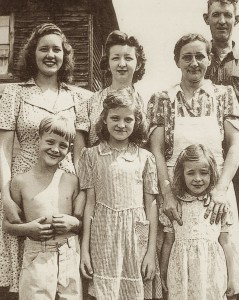 and then fry them the next day. Doesn’t it sound like we lived in the dark ages? But you know what Becky? We never went hungry. I was never hungry.”
and then fry them the next day. Doesn’t it sound like we lived in the dark ages? But you know what Becky? We never went hungry. I was never hungry.”
authentic place
I love to find three articles in the Sunday New York Times, and juxtapose one against the other. On Sunday December 2, 2012, I found three articles about three people that situated my mind into a particular place. In the Arts section, actor Bill Murray spoke to a writer about his unpremeditated career. Thinking about who he is-or who he could be in a film he said, “I wouldn’t have cast myself.” Bill Murray and his identity intrigues me. I have been thinking about what it means to be authentic, without external pressures. What does it mean to describe, analyze, synthesize and render an authentic experience in life…in landscape?
I was surprised to learn about Agnes Denes, an artist with “more to say” beyond the confines of a canvas. An identity might not be contained. Many people attribute her to be the one to create “the first ecologically conscious earthwork, “Rice/ Tree/Burial, a performance piece that involved planting rice seeds in a field in upstate New York, chaining surrounding trees and burying a time capsule filled with copies of her haiku.” She is a living example of an identity unfolding. She changed her life to wake up each morning, roll out of bed to make art in the space that she lives. As her gallery agent, described, “It’s difficult to get your head around all the things she’s done,” Ms. Tonkonow added. “I do honestly think that’s why she hasn’t been a household name.” Has her identity become unexpected, uncategorized like Murray?
Artist Karen Rosenberg’s work in this section is an unfolding story, a spatial kinetic sculpture with people and movements designed “to rustle a giant piece of fabric.” Set apart from this is “a writer scribbling response.” It is literally a deconstructed story, conceptually occupying space and time so it can be comprehended.This is a smaller story than the other two and perhaps less important today.
